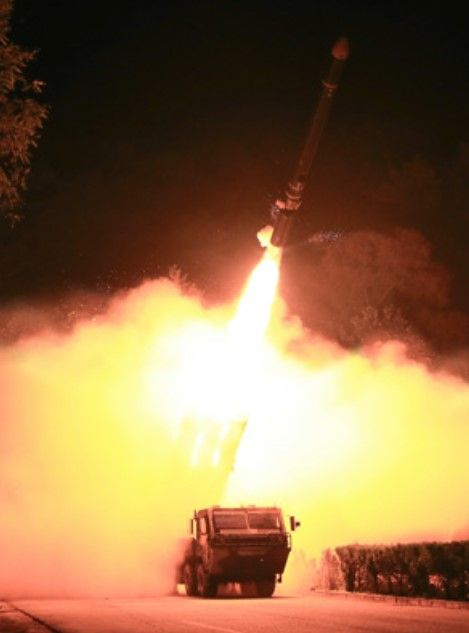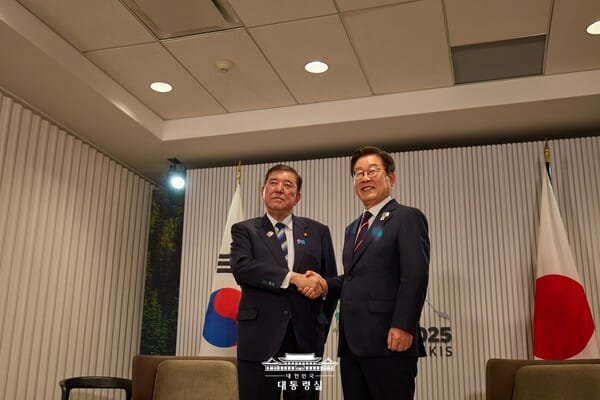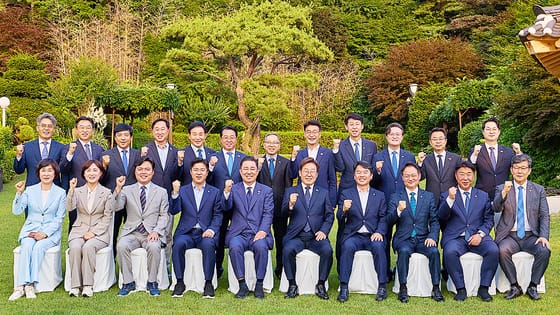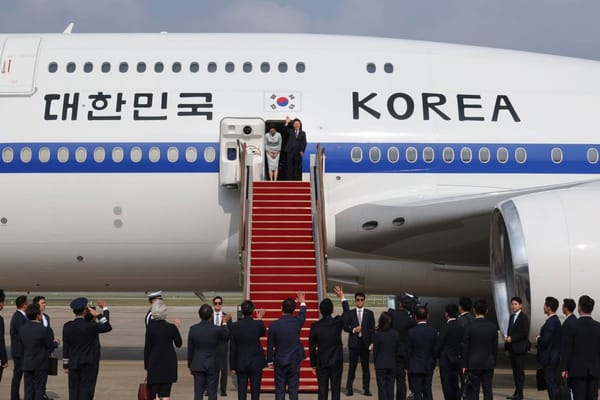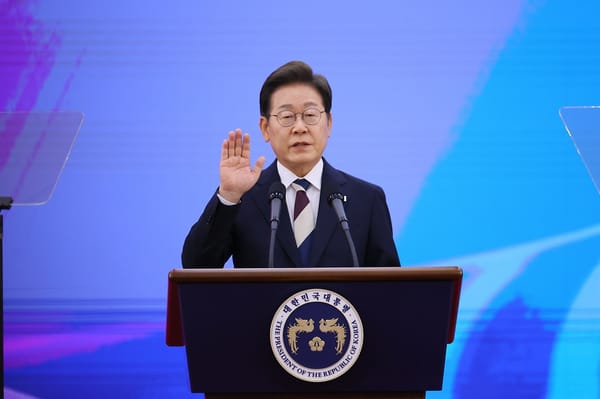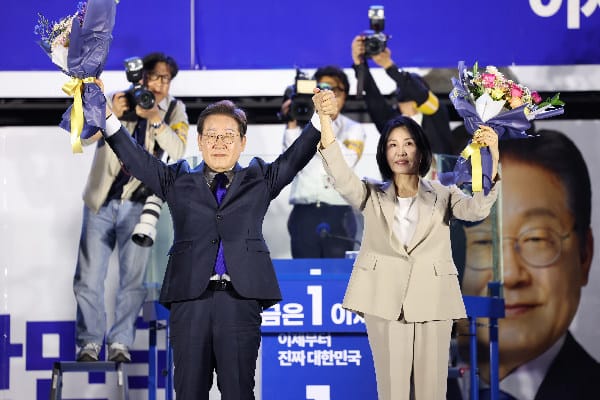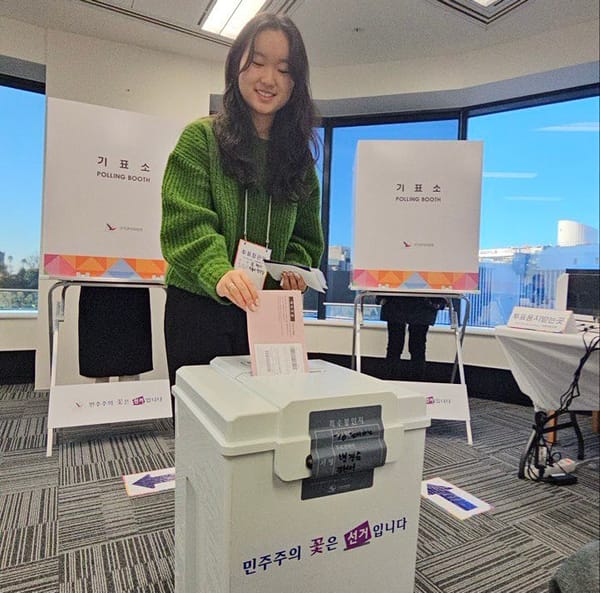Photo: North Korea tests artillery. Credit: Rodong Shinmun.
In the second week of October, North Korea continued to escalate tensions as South Korea debated having its own nuclear weapons. Also: the partisan visions of South Korea's grand strategy.
HEADLINES
- North Korea continued to escalate tensions by scrambling fighter jets and conducting artillery drills. Continuing the recent trend of missile tests and other demonstrations, on October 14, North Korea tested a short range ballistic missile over the East Sea 동해. Around the same time, approximately ten North Korean fighter jets approached the no-fly zone between the two Koreas set by the September 19 Military Agreement 9.19 군사합의 before turning around. The North Korean artillery also fired more than 170 shells off the eastern and western coast of the Korean Peninsula, into the neutral zone set by the September 19 Military Agreement.
The September 19 Military Agreement, entered in 2018, is the most significant result of the inter-Korean talks that followed the escalation of tensions in 2017. The agreement set an expanded neutral area along the demilitarized zone (DMZ), disarmed the area near the Armistice Line 휴전선 by relocating guard posts and setting up communication hotlines to prevent accidental military encounter.
South Korea’s Joint Chiefs of Staff 합동참모본부 said North Korea’s shelling of the neutral zone is a “clear violation of the September 19 Military Agreement." Previously, the Yoon Suk-yeol 윤석열 administration had said South Korea would respond to any violation by North Korea of the agreement with “reciprocity,” allowing for the possibility for the agreement to be abandoned.
- In response to North Korea’s provocations, the Yoon Suk-yeol administration and the ruling party raised various possibilities of nuclear armament. Chosun Ilbo 조선일보 reported that, in case of a North Korean nuclear test, the Yoon administration requested the United States for nuclear weapons sharing in the form of placing a nuclear-armed submarine or aircraft carrier at all times. Other ruling party leaders, such as the People Power Party 국민의힘 leader Jeong Jin-seok 정진석 and the Daegu mayor and former presidential candidate Hong Jun-pyo 홍준표 대구 시장, argued for a deployment of tactical nuclear weapons in South Korea or South Korea’s development of own nuclear weapons.
US National Security Council spokesman John Kirby said the goal of the United States was a diplomatic solution toward the denuclearization of the Korean Peninsula, indirectly declining the calls for the deployment of tactical nuclear weapons in South Korea. The Ministry of National Defense 국방부 and Ministry of Foreign Affairs 외교부 also did not endorse the tactical nuclear weapons idea, saying instead that Seoul is in discussion with Washington for extended deterrence against North Korea.
- The two major parties clashed over the US-Japan-South Korea joint naval exercise in the East Sea 동해, spurring a re-litigation of the history of Imperial Japan’s colonial occupation of Korea. Noting that during the joint exercise held on September 30, Japan’s Maritime Self Defense Force ships approached the Dokdo Islets 독도, the easternmost point of South Korea’s territory over which Japan claims ownership, Democratic Party chairman Lee Jae-myung 이재명 당대표 called out the Yoon Suk-yeol 윤석열 administration for engaging in “pro-Japan national defense.” (See Dig Deeper below.)
The history of Imperial Japan’s occupation of Korea in the early 20th century has emerged lately as a major partisan divide. (See previous coverage, “The Resurgent ‘New Right’”.) In response to Lee’s comment, People Power Party 국민의힘’s leader Jeong Jin-seok 정진석 argued: “Joseon 조선 fell because it was rotting from within. Japan never warred with the Joseon Dynasty” - a tendentious claim that elides the fact that Imperial Japan conducted numerous battles against the last dynasty of Korea without a formal declaration of war.
Democratic Party Floor Leader Park Hong-geun 박홍근 민주당 원내대표 called the remark “a typical colonizer’s view of history that Imperial Japan used to invade Korea.” Several PPP Assembly Members also criticized Jeong’s remark, with Assembly Member Kim Ung 김웅 국회의원 calling it “a typical logic of the wrongdoer.”
- The Bureau of Audit and Inspection (BAI) 감사원 requested investigation of several high-ranking Moon Jae-in 문재인 administration officials regarding North Korea’s killing of a South Korean civilian. In September 2020, a minor official of the Fisheries Ministry 해양수산부 attempted to defect into North Korea by abandoning his ship and swimming across the Armistice Line 휴전선. After interrogating him at sea, the North Korean military executed the South Korean civilian. The Yoon Suk-yeol 윤석열 administration has claimed the civilian was not attempting to defect, although none of the facts of the case have changed. (See previous coverage, “Desperate Yoon Turns to McCarthyism.”)
On October 13, the BAI referred former Defense Minister Seo Uk 서욱 전 국방부 장관, former spy chief Park Ji-won 박지원 전 국정원장, former National Security Advisor Seo Hun 서훈 국가안보실장 and 17 other Moon administration officials for an investigation by the Public Prosecutors’ Office 검찰청. The BAI alleged that Moon administration officials did not have sufficient evidence to determine the South Korean civilian had attempted to defect, and did not take measures to rescue the civilian when they learned he was floating in North Korean waters.
In the legislative audit of the Coast Guard 해양경찰청 held on the same day, chief of the Coast Guard Jeong Bong-hun 정봉훈 해양경찰청장 repeatedly refused to state definitively whether the South Korean civilian was attempting to defect. While Jeong said the Coast Guard found “no evidence” that the civilian was attempting to defect, he also declined to say the civilian reached North Korean waters accidentally, despite persistent questions from Assembly Members from both sides of the aisle.
DIG DEEPER
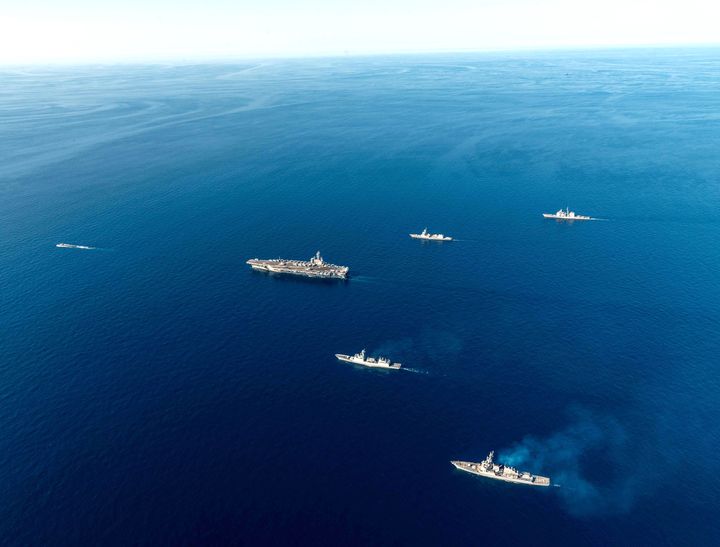
Photo: US-Korea-Japan joint navel exercise. Credit: Republic of Korea Navy.
The Liberal and Conservative Grand Strategies
Japan’s participation in the joint naval exercise in the East Sea 동해, together with the United States and South Korea, has become fodder for partisan arguments. Democratic Party chairman Lee Jae-myung 이재명 당대표 called out the Yoon Suk-yeol 윤석열 administration for engaging in “pro-Japan national defense,” to which Jeong Jin-seok 정진석, chair of the People Power Party’s emergency response committee 국민의힘 비상대책 위원장, responded testily: “Joseon 조선 fell because it was rotting from within. Japan never warred with the Joseon Dynasty” - a tendentious but common claim among South Korea’s right-wing.
But it is a mistake to dismiss this argument as a meaningless squabble based on heated language alone. Underlying this argument is a genuine difference in grand strategy that South Korea’s liberals and conservatives envision for their country, particularly with respect to the East Asian order that is shaped by the United States.
Since Roh Moo-hyun 노무현’s presidency from 2002 to 2007, South Korea’s liberals have pursued autonomous defense capacity that had the ability to project power beyond the confines of the Korean Peninsula. Jokingly nicknamed “the militarist of hopes and dreams” by his admiring supporters, Roh set off in 2005 on a mad dash to enhance South Korea’s conventional weapons capabilities with the Military Reform Plan 2020 국방개혁 2020, increasing the defense budget by an average of 8.8% per year over the five years of his administration.
The Moon Jae-in 문재인 administration actualized Roh’s vision in both in terms of physical capacity and policy direction. Under Moon, South Korea began producing its own attack submarines and supersonic fighter jets, and began constructing a light aircraft carrier. Moon also established the New Southern Policy 신남방정책, building greater ties with southeast Asian nations in a way that complemented the United States’ Indo-Pacific policies in the South China Sea.
The net result of these policies is putting South Korea on an equal footing with Japan as a regional partner of the United States in East Asia - which does not sit well with South Korea’s conservatives. Fixated on the North Korean threat, South Korea’s conservatives think it is a waste of time and money for South Korea to project power beyond the Korean Peninsula.
For example, conservative Assembly Member Sin Won-sik 신원식 has argued against South Korea’s aircraft carrier: “If we introduce the carrier, all it will do is to assist the US Pacific Fleet.” Although the Navy stressed the need to respond to China’s increasing number of aircraft carriers, Sin dismissed such concerns: “China’s carriers are not aimed at us; they are for the United States.” For conservatives, a grand strategy is for bigger countries like the US or Japan. A country like South Korea must play itself small, and receive every help against the North Korean threat.
But the conservative vision no longer matches today's reality, in which South Korea’s military advantage over North Korea is overwhelming. It is also contrary to the policy direction of the United States, which is shifting toward requiring its allies to share a greater burden. So far, conservatives have justified their policies by accusing liberals of being soft on North Korea and irrationally resentful of Japan. But it won't be long before reality catches up.
WEEKLY POLLS
For the second week of October, the approval rating for President Yoon Suk-yeol in the weekly regular Gallup Korea poll was 28% (-1). Yoon’s RealMeter approval rating was 33.1% (+1.1). The approval rating for the ruling People Power Party was 32% (-1), while the approval rating for the opposing Democratic Party was at 38% (+6) in the Gallup Korea poll. The same numbers for RealMeter were 36.3% (+1.1) and 46.4% (-2.8).
Data of the Week: 70 is the New 65. At what age does one become a senior citizen? The question has significant implications for South Korea’s policy making as the country grays rapidly. In most cases, public benefits for senior citizens such as the basic pension 기초연금 and free subway rides begin at age 65. But according to a survey by Oxopolitics 옥소폴리틱스 conducted on October 6, only 64.1% of respondents said 65-year-olds should be considered “elderly.”
Even among those aged over 60 years old, only 32% said 65-year-olds should be considered elderly. When do you get old, then? In the same survey, 52.7% overall said senior citizenship begins between 70 and 74 years old.
BUSINESS AND TECHNOLOGY

Photo: Legoland Korea. Credit: Legoland Korea.
Was Legoland Bankruptcy Politically Motivated? South Korea’s bond market was shaken when, on September 28, the newly elected Gangwon-do Province governor Kim Jin-tae 김진태 announced that the provincial government will not pay back the debt of the Gangwon Jungdo Corporation (GJC) 강원중도개발공사, a special purpose entity established to construct and operate the Legoland amusement park in Chuncheon, Gangwon-do Province 강원도 춘천. Rather than honoring the debt, Kim said, GJC will undergo a restructuring, making it inevitable that holders of GJC’s bonds will take a significant loss.
Legoland Korea, which had only opened five months ago in May, immediately fell into financial difficulties. Nevertheless, the bonds issued by GJC, valued KRW 205b (USD 143m), were considered a safe investment with an A1 rating, as they were guaranteed by the provincial government. With Kim’s announcement, however, GIC’s commercial paper ratings dropped overnight to D rating, or below junk bond status.
Some have criticized Kim, who was elected in the Local Elections 지방선거 held in May, for making a politically motivated decision. Opening Legoland in Chuncheon was a signature achievement of the outgoing liberal governor Choi Mun-sun 최문순, whose aggressive drive for development made Gangwon-do Province one of the few non-Seoul areas in the country to have increased in population in recent years. (See previous coverage, “Gangwon-do Revitalized.”) But Kim, a far-right personality known for his denial of the massacre in 1980 Gwangju Uprising 광주항쟁, may have been unwilling to honor the debt that Choi left behind.
Kim’s sudden turnabout is putting a chill on South Korea’s capital market, especially for project financing for local governments. Desperate to stem the drain of population to the Seoul metro area, South Korea’s provincial governments have raised funds for development projects in a manner similar to Gangwon’s structure for the Legoland development. Currently, more than ten local governments have issued asset-backed commercial papers similar to GJC’s for over KRW 1.3t (USD 0.9b), to finance projects like developing an industrial complex. The precedent set by Gangwon-do could cause the ratings agency to reconsider the A1 ratings given to similar bonds.
BUZZ OF THE WEEK
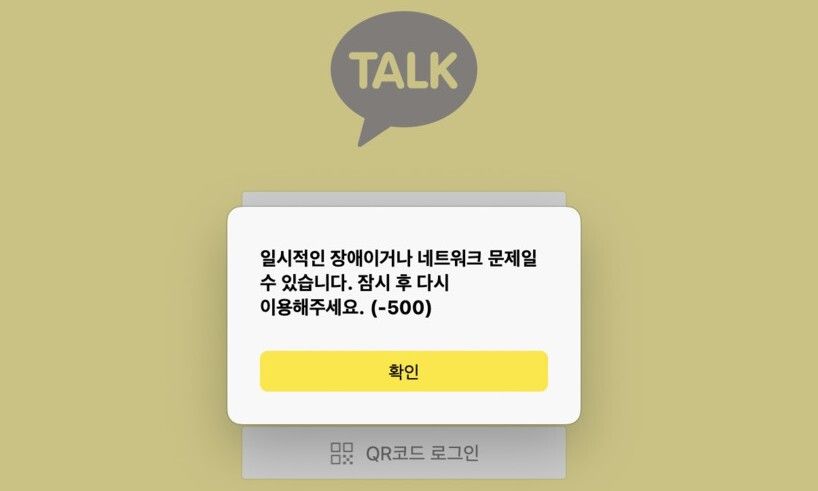
Image: Kakao Talk's error message. Credit: the Blue Roof.
Kakao Talk Outage Leaves South Korea Stranded. On October 15 at around 3:30 p.m., a data center operated by SK C&C in Pangyo, Gyeonggi-do Province 경기도 판교 caught fire, damaging one of South Korea’s most important pieces of infrastructure: Kakao Talk 카카오톡, the super-app through which most Koreans send messages, hail cabs, get directions, make payments, play video games, etc. After eight hours spent extinguishing the fire and another two to restore the service, Kakao Talk slowly began to come back online at around 1 a.m. the next day, with significant portions of the service not returning for another day.
The outage is the longest in Kakao’s twelve year history. Kakao Talk’s monthly active users within South Korea is over 47.4m, or more than 90% of South Korea’s population. The country’s dependence on Kakao Talk is deep and wide: in addition to simply exchanging greetings, for example, many South Korean companies use the messenger app as the primary means of communication for work, akin to Slack in the United States.
As Kakao Talk failed, businesses ground to halt, taxis were available only by waving at them by the curb, and some users were hit with a KRW 500k (USD 410) charge for the motorized scooter rental that they could not check back in. Even the Office of the President 대통령실 ordered a cabinet ministry level emergency response, saying the outage could be “a critical problem for national security.” Namgung Hun 남궁훈 and Hong Eun-taek 홍은택, co-chief executive officers of Kakao, Inc., issued a statement of apology six hours into the outage.
As the outage left South Korea stranded, Kakao’s data center planning came under criticism. Kakao was not the only major tech company that was using the SK C&C data center that caught fire; Naver 네이버, South Korea’s search engine giant, used the same data center, but was able to recover its services within a few hours. Naver’s quick response was thanks to diversified data centers, many of which Naver operates directly.
In contrast, Kakao rents all of its servers and has most of them within the same data center. Kakao’s vice president Yang Hyeon-seo 양현서 said “our response ran into difficulties since all 32k servers going down at the same time is an unprecedented event in IT history” - calling into question why 32k servers were in the same location in the first place.
THAT’S IT FOR THE SECOND WEEK OF OCTOBER. SEE YOU NEXT WEEK.
Like TBR Newsletter? Don’t keep it to yourself. Friends and colleagues can sign up here.
We welcome your feedback! Contact us at admin@blueroofpolitics.com.


